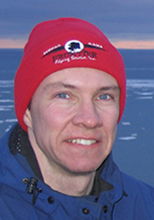David Atkinson

Position
Contact
Credentials
PhD (Ottawa)
Area of expertise
Climate; weather and human and natural systems; data analysis; modelling; the Arctic
My main interest centers around understanding how weather affects an array of human and natural systems, in particular along coastal regions and in the marine environment, using an array of techniques including computer model analysis, human interviews, and field instrument deployments. My region of specialization is the Arctic.
I came to the Department of Geography in 2010 after working for 6 years as a research scientist and professor at the International Arctic Research Center/Department of Atmospheric Sciences at the University of Alaska Fairbanks (2004-2010).
Before that I held Post-Doc positions at Bedford Institute of Oceanography, focusing on environmental forcing of arctic coastal regions (2002-2004), and the University of Ottawa, focusing on high-arctic data issues and computer methods for hemispheric paleo-climate reconstruction (2000-2002).
My PhD (University of Ottawa, 2000) focused on high-arctic climate issues that included data rescue work (Polar Continental Shelf Project database), statistical analyses, and the development of a distributed surface air temperature prediction model.
Research
The backbone of my research efforts have always been the large laboratories of competent graduate students I have been privileged to work with since I started in a faculty role in 2004. Graduate students I have supervised or co-supervised are in parentheses below.
A major focus concerns the "environmental forcing" of northern coastal zones. Environmental forcing can come in the form of wave action (Francis), storm surge (Wilks, Asplin, Cross), or more esoteric but equally important phenomenon such as coastal slush-ice berms (Eerkes-Medrano). Again, aspects of this work required direct engagement with Alaska Indigenous communities to identify the environmental circumstances under which a slush-ice berm will form. Students from my laboratory spend a lot of time in Indigenous communities and with northern industry and the Coast Guard to define in specific, operational terms what is good and bad weather and then relating that back to large scale weather patterns. This work has proven to be a considerable establishment of methodological innovation for engaging diverse end user groups (Eerkes-Medrano). Major funding has come from MEOPAR (Marine Environmental Observation, Prediction and Response).
Another major research area is storm representation in model environments, where “storm” is defined meteorologically (dos Santos Mesquita, Pingree-Shippee) as well as operationally (Shippee). The operational consideration came from work we have done with shipping companies, to understand what they mean by “good weather” and “bad weather”, and then integrating this into shipping suitability indices for high latitudes.
Other research efforts include examining manifestations of weather at the local scale (e.g. fog, severe wind events, extreme temperature inversions) to understand the nature of their occurrence (e.g. how often) and under what large-scale weather conditions they occur (Maligowski, Jobard, Khalilian, Elgundi). This work involves partnership with Environment and Climate Change Canada and has been supported by ArcticNet.
A more recent research direction for me has been to investigate snow pack response to daily and hourly fluctuations in the large-scale weather (March, Courtin, Paquette-Struger, Baker). This is involving a major partnership with Glaciology Section of NRCan/Geological Survey of Canada, Parks Canada, and University of Saskatchewan. This work has been supported by NSERC, Canada Foundation for Innovation and British Columbia Knowledge Development Fund.
Research has also focused on data analysis and data-preparation work (Wang) and specialized modeling efforts (Gourand). Other partnerships with Agriculture and Agrifood Canada have allowed research into crop disease occurrence (Wu), and with the BC Ministry of Environment for work on pollution occurrence in cities (Li, Mihara, Tergesen).
Much of our work is field based, both community/end-user visits as well as deploying of instrumentation into the ocean, along the coast, or onto mountain icefields.
Teaching
I currently teach our graduate advanced quantitative analysis course, which focusses on advanced statistical analytical methods in a Python programming environment (GEOG 524).
I also teach a third year applied climatology course, in which we examine some of the many intersections between human activity and weather and climate (GEOG 373), and a fourth year synoptic meteorology course (GOEG 484), in which we take a professional field instrumentation course (generously provided by Campbell Scientific Canada Corp.)
In my courses I strive to provide teaching explorations that reflect real-world occurrences and linkages, and opportunities/experiences that provide skills which reflect real-world job realities.
Publications
Faces of UVic Research video
In this video, David discusses how his research analyzes storms and their effects on people and the environment.
